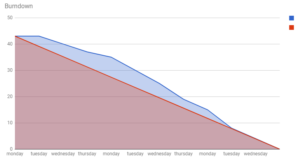 Are we doing Agile well? Answering this question seems to be top of mind. However, the solutions proposed are not always that Agile from the outset. Recently I received a piece of thought ware on this subject that was less then Agile in my humble opinion. It wanted to answer the question ‘Are we doing Agile well?’ by measuring:
Are we doing Agile well? Answering this question seems to be top of mind. However, the solutions proposed are not always that Agile from the outset. Recently I received a piece of thought ware on this subject that was less then Agile in my humble opinion. It wanted to answer the question ‘Are we doing Agile well?’ by measuring:
- Velocity Variance (Lower is better)
- Story points committed vs delivered
- Sprint predictability
From my first impression, these metrics seem to be measuring a number of totally incoherent dimensions like Holiday seasons (velocity variance anyone?), lack of team ambition, sickness, etc. Focusing on these dimensions seems to be counterproductive. Any sane team being judged on these metrics would reduce their velocity to a point where variance becomes zero, avoid innovation and risks and all story points will be delivered and sprints become 100% predictable. The speed where these metrics are optimal is probably somewhere well below the optimum output of the team in question and thus results in wasted resources.
From my experience, any ‘performance metric’ based on story points is flawed as it will hurt performance or impede the actual value story points and velocity provide: aid in planning Agile development in the short and intermediate-term and help predict ROI. Using story points as a performance metric usually results in either ‘story point inflation’ or wasted resources.
The best way to get teams to perform and reach your goals is by measuring the value delivered. Of course, measuring this is hard (btw it shouldn’t be), but when you succeed it will pay off handsomely. It focuses all team members on maximizing the bottom line. This will result in the team stepping up to take ownership of the goals of your organization and huge leaps forward in effectiveness. It does open up the vulnerability of short term gains in favor of long term sustainability, but this is remedied by making sure your teams contain members with a long term commitment to your operations.
So which ‘metrics,’ other than value delivered, could an outsider use to determine how teams are performing or where you could help them improve?
- Burndown. Does it follow the ideal path? Or is it a steep drop on the last day of the sprint?
- Overhead in preparing stories and time spent in poker sessions. In my experience, these vary a lot.
- Participation and contribution of each single team member.
- How many innovative ideas do the teams generate to increase their effectiveness? (whether implemented or not)
- Impediments – are they reported? Or is everybody accepting the status quo?
Please share your thoughts and experiences on the topic in the comment section below.